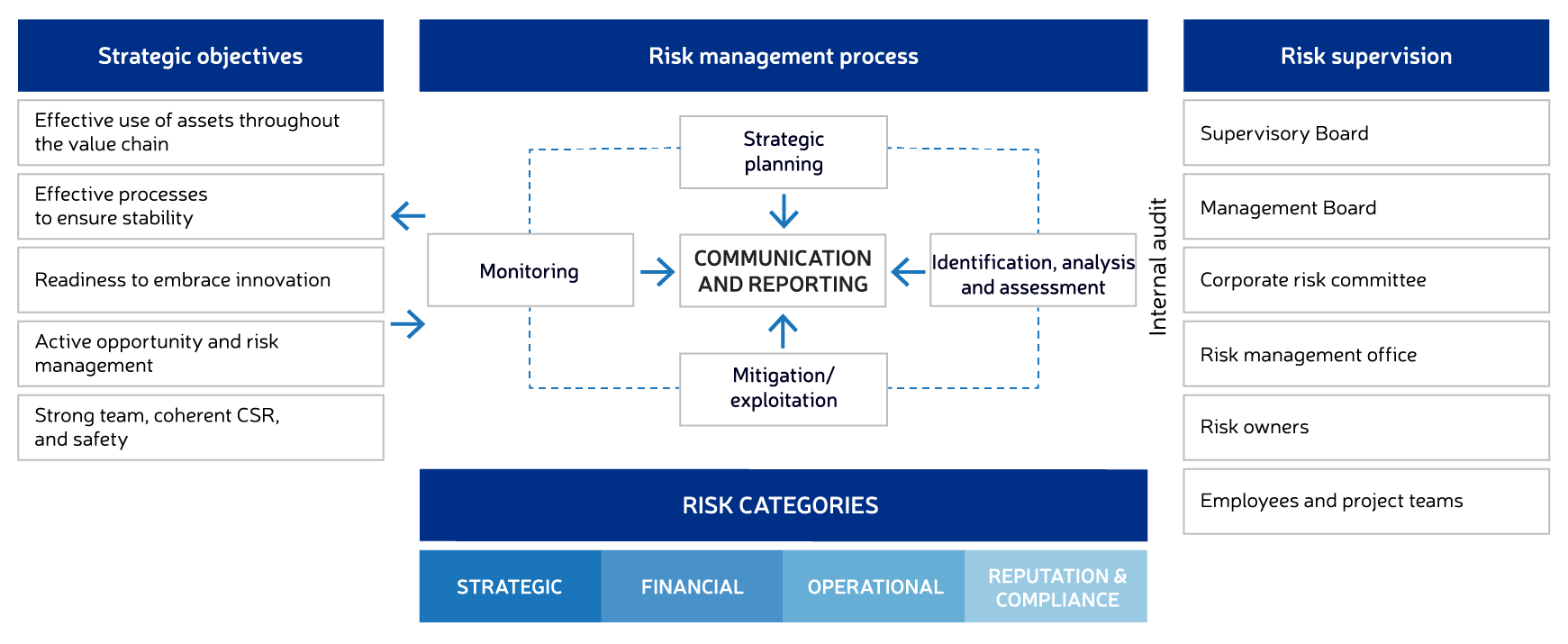1st LINE OF DEFENCEBusiness |
|
2nd LINE OF DEFENCERisk, Finance, Compliance |
|
3rd LINE OF DEFENCEInternal audit |
|
Risk management
The LOTOS Group is socially responsible and follows the principles of sustainable development. As part of its corporate risk management, it identifies risks in its business and undertakes measures to eliminate those related to the personnel, social matters, respect for human rights and the environment, and works to counteract corruption.
The LOTOS Group has implemented an Enterprise Risk Management (ERM) system to boost the effective implementation of its business strategies and processes. The above measures have been implemented as part of the Enterprise Risk Management Policy.
Risk management model
Mechanisms of the risk management model are embedded in the existing business processes. The model comprises three defence lines which are adjusted to the nature of particular activities and the possible impact of risks on the Group’s performance.
Risk management model at the LOTOS Group
Structure of the Enterprise Risk Management (ERM) system
The ERM system focuses on key risks and forecasts their impact on the company’s operations and performance, thus facilitating the development of pre-emptive measures that may help mitigate or exploit risks or their consequences. This key functionality of the system is currently being strengthened at the LOTOS Group.
ENTERPRISE RISK MANAGEMENT SYSTEM AT THE LOTOS GROUP

Risk management process
Management of opportunities and threats at the corporate level is carried out as part of a process involving:
ENTERPRISE RISK MANAGEMENT PROCESS AT THE LOTOS GROUP
Risk management in view of climate change and new market requirements
The LOTOS Group is a listed company. Therefore, it maintains a compliance system (“Compliance System”) which covers all its organisational units and subsidiaries. The Compliance System prevents and mitigates legal risks by ensuring compliance of the business with legal requirements.
The LOTOS Group analyses the potential impact of climate change megatrends by identifying opportunities and threats to its operations and growth prospects.
The key risks for Grupa LOTOS S.A. arising from climate change are the regulatory risks related to meeting the required levels for the National Indicative Target (NIT) and the National Reduction Target (NRT) in 2020 (8.5% for NIT and 6% for NRT).
Ensuring that fuels for internal combustion engines contain the proper amount of biocomponents (achievement of the NIT) is extremely difficult and entails very high costs for the entire industry considering technological capabilities (fuel quality requirements) and market capabilities (limited market of suppliers).
A failure to meet the required NIT level may result in the necessity to pay high fines. This is why the LOTOS Group and other key industry representatives have entered into legislative dialogue with the Ministry of Energy concerning the feasibility of meeting the legal requirements.
Similarly, meeting the National Reduction Target (reduction of life cycle greenhouse gas emissions) under the current regulatory regime is hindered by the necessity to incur high costs and, as in the case of the NIT, by a limited market of emission reduction mechanisms. The LOTOS Group analyses and uses all means of effectively reducing emissions and conducts a dialogue with the regulatory body on how to achieve the required NRT level.
Apart from the identified and addressed threats, the LOTOS Group also sees opportunities in climate change and macroeconomic trends, and is pursuing a growing number of projects consistent with the megatrends.
One such project is active entry into the electromobility market. Under the ongoing Blue Trail project, the first 12 electric vehicle charging points have been launched at LOTOS service stations on the route between the Tricity and Warsaw. More charging points are planned at expressways and motorways in the coming years. By the end of Q1 2020, a total of 38 new EV charging points are to be launched.
The year 2020 will see further environmental restrictions coming into force. The International Maritime Organisation (IMO) is introducing a new global limit on sulphur content in marine fuels, changing the current 3.5% to 0.5% m/m. Therefore, LOTOS has embarked on a project to increase the share of low-emission fuels through the use of LNG as marine fuel. Another response of the Group to the new regulations is the EFRA Project, which will help address the problem of heavy residue from crude oil processing. Heavy residue is currently being used for the production of asphalt, an important component in road construction, as well as high-sulphur heavy fuel oil, used primarily as marine fuel. It is a product with a negative margin, i.e., its price is lower than that of crude oil. Being environmentally unfriendly, it is difficult to sell now, and starting from 2020, its sale will become virtually impossible. EFRA will make it possible to sell approximately 1.1m tonnes of excellent quality fuels, mainly diesel oil, produced from the heavy residue.
In addition to its pure business-oriented projects, the LOTOS Group actively engages in promoting the use of hydrogen in transport. On the Group’s initiative, the Hydrogen Technologies and Clean Energy Technologies Cluster has been established, with a mission to initiate efforts aimed at increasing the role of hydrogen technologies.
As part of its strategy, the Group seeks to become the leader of new generation fuels. In order to implement these plans, the Innovation Division initiates and coordinates the implementation of innovative projects. In September 2018, representatives of the LOTOS Group signed documents initiating joint R&D activities with the Warsaw University of Technology. The cooperation will involve the development of prototypes of selected low-carbon transport and energy storage equipment. In March 2019, a similar document was signed with the Gdańsk University of Technology.